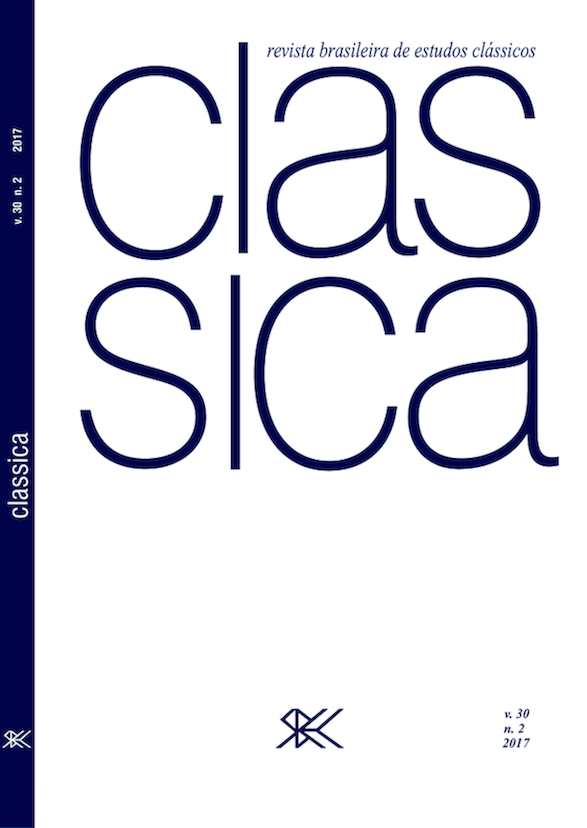An Unknown Correlation in Hexametric Poetry and the Interpretation of the Brevis in Longo Principle
DOI:
https://doi.org/10.24277/classica.v30i2.435Palavras-chave:
Dactylic Hexameter, Brevis in Longo, Ancient Greek Metrics, Bucolic Diaeresis, Hepthemimeral Caesura, Homer, Apollonius Rhodius, Nonnus.Resumo
The goal of this paper is to show that (some) Ancient Greek hexametric poets were not indifferent to the quantity of the final syllable of the verse, by studying the correlation between that quantity and the different possible word ends in the fourth foot of the verse. The results of the study suggest that in some poets there was a certain preference for “rhythmic coherence” within the second colon, which indicates that, even if there was “compositional indifference” regarding the quantity of the last syllable, there was not “actual indifference”.
Downloads
Referências
AGRESTI, A. An Introduction to Categorical Data Analysis. New Jersey: Wiley, 2007.
ALLEN, W. S. Correlations of Tone and Stress in Ancient Greek. In: To Honor Roman Jakobson. Den Haag: Mouton, 1967. v. 1, p. 46-62.
ALLEN, W. S. Accent and Rhythm. Cambridge: Cambridge University Press, 1973.
BRIOSO SÁNCHEZ, M. Aportaciones al estudio del hexámetro de Teócrito. Habis, v. 6,
p. 21-56 y v. 7, p. 57-76, 1976/1977.
BULLOCH, A. W. A Callimachean Refinement to the Greek Hexameter. CQ, v. 2, p. 258-268, 1970.
DALE, A. M. Observations on Dactylic. WS, v. 77, p. 15-36, 1964.
DAVID, A. P. The Dance of the Muses. Choral Theory and Ancient Greek Poetics. Oxford: Oxford University Press, 2006.
DEVINE, A. M.; STEPHENS, L. D. Language and Metre. Chico, California: California Scholars Press, 1984.
DEVINE, A. M.; STEPHENS, L. D. The Prosody of Greek Speech. New York: Oxford University Press, 1994.
FANTUZZI, M. Variazione sull’esametro in Teocrito. In: FANTUZZI, M.; PRETAGOSTINI, R. (Ed.) Struttura e storia dell’esametro greco. Roma: Gruppo Editoriale Internazionale, 1995. v. I, p. 221-264.
IRIGOIN, J. Colon, vers et période (à propos d’un choeur des Núees d’Aristophane). In: WESTENDORP BOEMA, R. E. H. (Ed.) Κωμῳδοτραγήματα: Studia Aristophanea, viri Aristophanei W. J. W. Koster in honorem. Amsterdam, 1967. p. 65-73.
JONES, F. P.; GRAY, F. E. Hexameter Patterns, Statistical Inference and the Homeric Question: An Analysis of the La Roche Data. TAPhA, v. 103, p. 187-209, 1972.
KORZENIEWSKI, D. Griechische Metrik. Darmstadt: Wissenschaftliche Buchgesellschaft, 1968.
LEEDY, D. Singing Ancient Greek: A Guide to Musical Reconstruccion and Performance, eScholarship (http://escholarship.org/uc/item/1rj4j3n1), 2014.
LUQUE MORENO, J. Hexámetros especiales. RELat, v. 5, p. 117-145, 2005.
MAAS, P. Greek Metre, trans. H. Lloyd-Jones. Oxford: Clarendon Press, 1962.
MAGNELLI, E. The Nonnian Hexameter. In: ACCORINTI, D. (Ed.) Brill’s Companion to Nonnus of Panopolis. Leiden: Brill, 2016. p. 353-371.
NAGY, G. Pindar’s Homer: The Lyric Possession of an Epic Past. Baltimore: Johns Hopkins University Press, 1990.
O’NEILL Jr., E. G. The Localization of Metrical Word Types in the Greek Hexameter. YClS, v. 8, p. 103-178, 1942.
RYAN, K. M. Gradient syllable weight and weight universals in quantitative metrics. Phonology, v. 28, p. 413-454, 2011.
SICKING, C. M. J. Griechische Verslehre. München: C. H. Beck, 1993.
SMYTH, H. W. A Greek Grammar for Colleges. New York: American Book Company, 1956.
Van RAALTE, M. Rhythm and Metre. Towards a Systematic Description of Greek Stichic Verse. Assen: Van Gorcum, 1986.
WEST, M. L. Greek Metre. Oxford: Oxford University Press, 1982.
Downloads
Publicado
Edição
Seção
Licença
Autores que publicam nesta revista concordam com os seguintes termos:
a. Autores mantém os direitos autorais e concedem à revista o direito de primeira publicação, com o trabalho simultaneamente licenciado sob a Creative Commons Atribuição 4.0 Internacional (CC BY 4.0) que permite o compartilhamento do trabalho com reconhecimento da autoria e publicação inicial nesta revista.
b. Autores têm autorização para assumir contratos adicionais separadamente, para distribuição não-exclusiva da versão do trabalho publicada nesta revista (ex.: publicar em repositório institucional ou como capítulo de livro), com reconhecimento de autoria e publicação inicial nesta revista.
c. Autores têm permissão e são estimulados a publicar e distribuir seu trabalho online após o processo editorial (ex.: em repositórios institucionais ou na sua página pessoal), já que isso pode gerar alterações produtivas, bem como aumentar o impacto e a citação do trabalho publicado (Veja O Efeito do Acesso Livre).
d. Autores autorizam a cessão, após a publicação, de seu conteúdo para reprodução em indexadores de conteúdo, bibliotecas virtuais, bases de dados de acesso público e similares.











